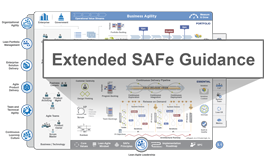Agile Workspaces
Note: This article is part of Extended SAFe Guidance, and represents official SAFe content that cannot be accessed directly from the Big Picture.
Adopting Lean and Agile practices across the Enterprise greatly benefits from a physical environment for teams and Agile Release Trains (ARTs) that supports these new ways of working. Experience and research have also shown that effective workspaces are one of the keys to high team productivity. Further, the environment must positively reinforce the cultural changes while amplifying the focus on face-to-face communication and information transparency.
We describe these physical spaces that encourage collaboration, communication, and innovation as Agile Workspaces. In this article, we’ll address three key topics and share best practices that have emerged:
- Workspaces for Agile Teams that balance the need to work together daily alongside occasional privacy
- Cross-Team Collaboration Spaces that support critical events such as PI Planning as well as encourage innovation
- Work Visualization Techniques that create transparency and alignment alongside opportunities to improve processes
Workspaces for Agile Teams
In the search for ever higher productivity and employee engagement, many enterprises have experimented with team workspaces explicitly designed to support Agile development[1]. Such experiments are not easily conducted, as arranging and rearranging a physical workspace involves facilities, capital expense, potential interior remodels, and more. Out of these experiences, a few common requirements, some modestly self-conflicting, have emerged:
- Provide individual focus space for being ‘in the flow’ of developing code, tests, and other artifacts
- Support the need for constant informal team collaboration
- Support the need for occasional privacy
- Provide room for the team Daily Stand-up (DSU) and space for whiteboards, visual information radiators and at least one large monitor
In the field, we’ve observed practices at the extremes, from individuals in traditional cubicle farms to completely open workspaces designed for ad hoc pairing, teaming, and ease of reconfiguration. While opinions vary considerably (XP shops, in particular, appear to favor the fully-open pairing concept), in our experience, neither of the two extremes is optimal. Many organizations have arrived at what seems to be a fairly common and efficient design, as illustrated in Figure 1.
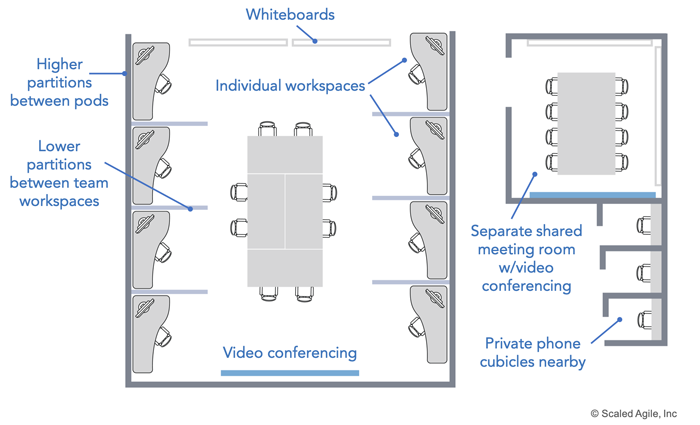
In this design, teams of 8-10 individuals work in a ‘pod’ of semi-private cubicles. Walls within the pod are low, allowing for informal discussions. Their focus space is inside their cubicle, yet it allows informal communication and ‘overheard’ knowledge gain within the team. However, the higher outside walls on of the pod largely separate the noise and conversation from the team next door. In addition, the gathering spaces in the middle provide an area for hoteling team members, spontaneous pairing, and quick, informal sessions. The pod is supported by whiteboards, a large monitor for video conferencing, and information radiators.
Ideally, the facilities on the right of Figure 1 augment the pod. The meeting room provides space for the team to post their information on the walls and collaborate with remote team members and other teams. When not in use by the teams, it also provides a retreat for private conversations. In some cases, these team rooms can be shared with other teams and serve as an informal conference room for others. Where feasible, a few private phone cubicles support the need for individual privacy. In some cases, these have been provisioned as movable and stand-alone ‘phone booths’ inside a more open workspace.
Workspaces for Remote Workers
Agile development is designed and optimized for co-located teams. (“The most efficient and effective method of conveying information to and within a development team is face-to-face conversation”). To this end, enterprises often spend significant time and energy establishing co-location. The Agile pod design above is a reflection of that.
However, co-location is not always feasible. Simply, some of the people who can contribute the most are not available to be located—or relocated—on site. The fact is that many Agile teams are distributed across geographies, sometimes with significant time zone differences.
We have both witnessed and participated in high-performing teams with a significant degree of distribution. While being distributed does not change the basic Agile ways of working, it does impose some requirements on the business and the remote workers.
- High bandwidth video and audio connectivity
- Tooling for team and program Kanban boards and backlogs
- A wiki or intranet site providing access to Strategic Themes, Portfolio Vision and other critical information
- Collaboration tools for communication, visualization and ideation
- Overlapping core hours for DSU, Iteration Planning, demos and other events
- Commitment to routinely travel to PI planning events
Cross-Team Collaboration Spaces
In our experience, successful cross-team collaboration needs to support two patterns of work. The first is the need to bring the entire ART together for critical SAFe events that happen on a predictable cadence. These include, but may not be limited to, PI planning, System Demos and Inspect and Adapt (I&A). Additionally, individuals need space to collaborate across teams, to innovate away from the pressures of their day-to-day work, generally in a workshop-style format when the need arises.
ART Collaboration Spaces
PI planning is the most critical event in all of SAFe. As such, a semi-dedicated physical space for planning is prudent and will pay for itself over time. In addition to the physical space, adequate communication channels must be established for attendees who cannot be present in person. For many enterprises, room for a single ART or two is about all that can be allocated permanently. Figure 2 provides a typical room layout for a PI Planning event.
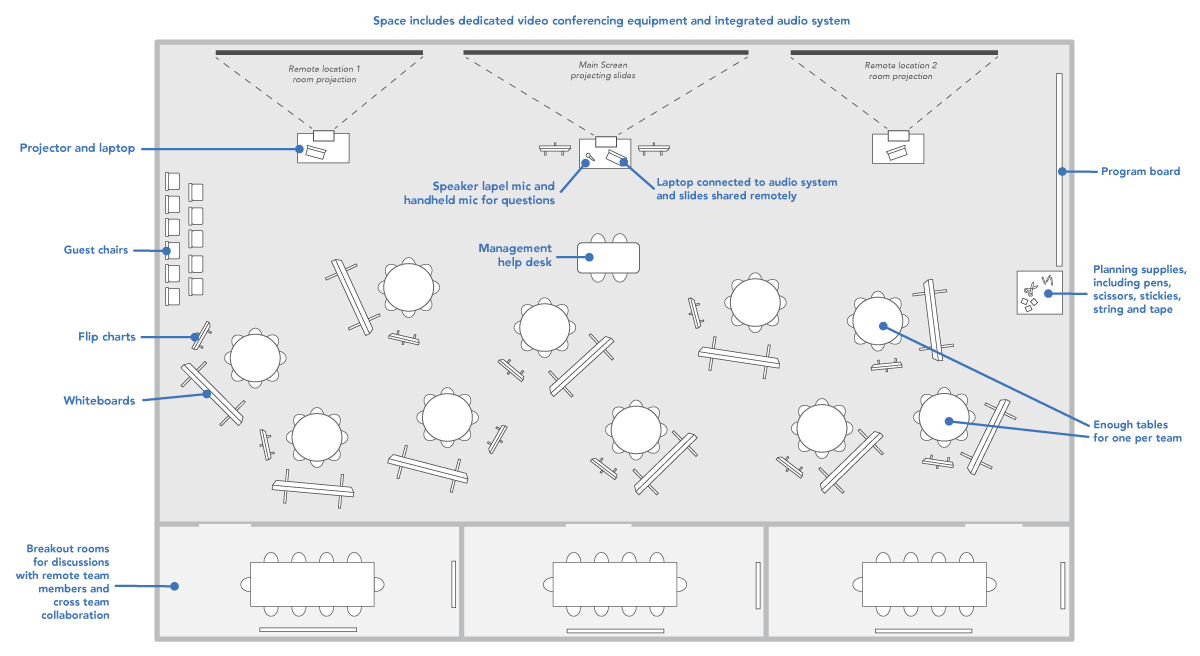
One special anecdote is the ‘management help desk.’ This emerged organically in one enterprise when it recognized that it was impractical for all the Business Owners to attend both full-day sessions each PI, at least initially. Their workaround was to create a ‘help desk,’ where one or more Business Owners was always present, and who could reach others on demand for real-time decision making. (Note: We think it was the ‘help desk’ sign that triggered one of the cultural turning points in that enterprise).
In larger multi-ART implementations, it may be impractical to provide a dedicated space large enough for all the ARTs. In this case, a single on-site ART planning location becomes the cornerstone, but facilitates are extended during PI planning to include hotel conference centers and other venues.
Of course, this space won’t be used just for the regular PI planning schedule. It will also host the system demo and the I&A, as well as additional team-sharing spaces during the PI. (This is covered in more detail below.) Alongside cadence and synchronization, a permanent location adds predictability, minimizes uncertainty, and reduces the transaction cost of organizing these events. In our experience, this space adds to the collaborative workspace strategy that benefits the Agile enterprise.
Providing Space for Innovation
Innovation is a different and inherently creative process, something apart from current roadmaps and features. To demonstrate real innovation, people will need time to let go of their day-to-day responsibilities and dwell on the larger problems and opportunities. This need encourages longer periods of backlog-free time to explore potential ideas, prototype and test those ideas with your current customers.
The physical environment plays an important role here, not only in creating a collaborative space away from the daily work. It also supports the variety of approaches used during the creative process. Success patterns that we have observed include the following:
- Ease of booking rooms – To ensure they are available for running creative and collaborative workshops, these rooms are prevented from being block-booked for recurring events. Excessively using these spaces for less critical purposes leads to delays in collaboration and innovation or teams giving up on trying to use the space.
- Facilitation kits – Inside this room and across the organization, facilitation kits should be readily available. These generally include pens, stickies, scissors, tape, etc., to support any innovation process. A working agreement ensures that the teams restock the kits and return them once they are finished, reducing the preparation overhead for the next team.
- Moveable whiteboards – Although fixed whiteboards in each room are beneficial for illustrating ideas and capturing information, they will need to be cleaned when the room is vacated. A better solution is moveable whiteboards that are wheeled in and then kept for a while, ensuring that the output is not lost and can be worked on in future sessions.
- Rearrangeable furniture – As the purpose of the event changes, the layout of the room will also need to adapt. Avoiding fixed furniture will allow people to set up these spaces for a variety of scenarios, such as multiple tables for group work, a lecture-style arrangement to present ideas, or removing the chairs and tables to create a completely open space.
- Video Conferencing Capabilities – Many times cross-team collaboration will involve a few individuals who cannot attend in person. ‘Always-on’ video conferencing capabilities in these spaces ensure that everyone can participate. In addition, the use of ‘robots,’ which the remote attendees can control to move around the room, enhances their inclusion.
Visualizing Work
Frequently, during various SAFe training forums, attendees ask, “but if I was to leave here and do only one thing to start to implementing Lean-Agile development at scale, what would it be?” Our answer is always the same: Visualize the work. That is why when you visit an Agile enterprise, you see work everywhere—on walls, whiteboards, monitors, wherever you look. Visualization converts the intangible to the tangible, flushes out unnecessary, unplanned, unapproved or duplicate work, and aligns everyone to the actual current state, as opposed to simply following the plan. The common thread across all these approaches is that the information is ‘always-on,’ with no effort needed to go and discover it.
Based on our experiences, we’ve recommended some starting points below.
Visualizing Who We are Working For
Agile development is obsessively focused on the customer; that’s one of the things we like most about it. To assure they are addressing the real problems of real customers, Agile Teams use ‘personas’ to bring the customer to life. (See Agile Product Delivery). It’s common to see even life-size cardboard cutouts of one or more personas in the team workspace. Along with the documented attributes of the persona, these serve as constant reminders of who the teams work for, and how they support the ‘jobs to be done’ by their real user.
Visualizing the Flow of Work
Lean teaches us that ‘you can’t manage what you can’t see.’ Making the current work visible exposes the amount of work in process, bottlenecks, what people are really doing as opposed to what we think they are doing, and highlights the status of the flow of value throughout the system. A general-purpose Kanban system can be used to manage any type of work following this approach. The left and right sides of Figure 3 show the Portfolio and Program Kanban systems we use at Scaled Agile to manage Epic and Feature flow.

In addition to monitoring the progress of work items through the system, dependencies between teams also warrant close attention. The program board, also visible in Figure 3 and created during PI planning, captures this information and should be displayed prominently during the PI. Successful ARTs use the program board as a focal point for their Scrum of Scrums events.
Visualizing Strategy
Figure 4 illustrates another example of visualizing work. In this image, we see an ‘investment corridor’ that identifies all current and potential epics in flight at one large enterprise. This corridor served as the planning visualization for a PI-like, large-scale portfolio prioritization workshop.
Rather than confining it to a room, information is ‘outside,’ making it easy for people to walk up and add their thoughts and suggestions. Also, making the information visible brings the strategy into the open and helps create alignment across the organization. Other examples we have seen often include the additions of the enterprise and Portfolio Strategic Themes, Vision and Roadmap, to give a full and rounded picture of the current and future direction of the business.
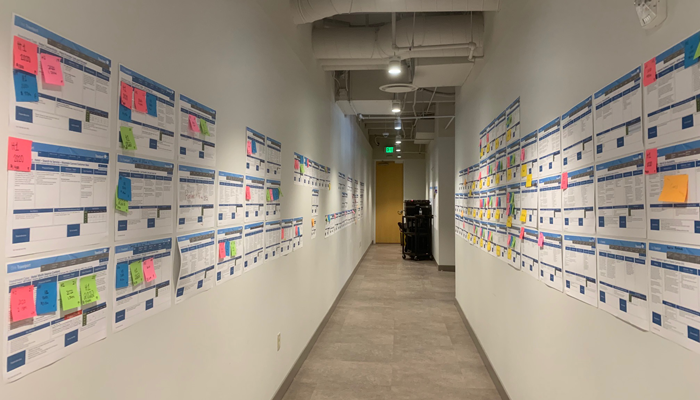
Visualizing Solution Health
Customer support teams have long seen the value in displaying the number of waiting calls, daily closed and open tickets, and current SLA levels prominently on monitors close to the teams who rely on that information. This approach has been adopted by Agile teams to include metrics on the state of the current solution. Examples of these include critical quality metrics, such as:
- Build health
- Number of defects
- Percentage of passing tests
- Load on, and performance of, the solution infrastructure
An example can be seen in Figure 5.
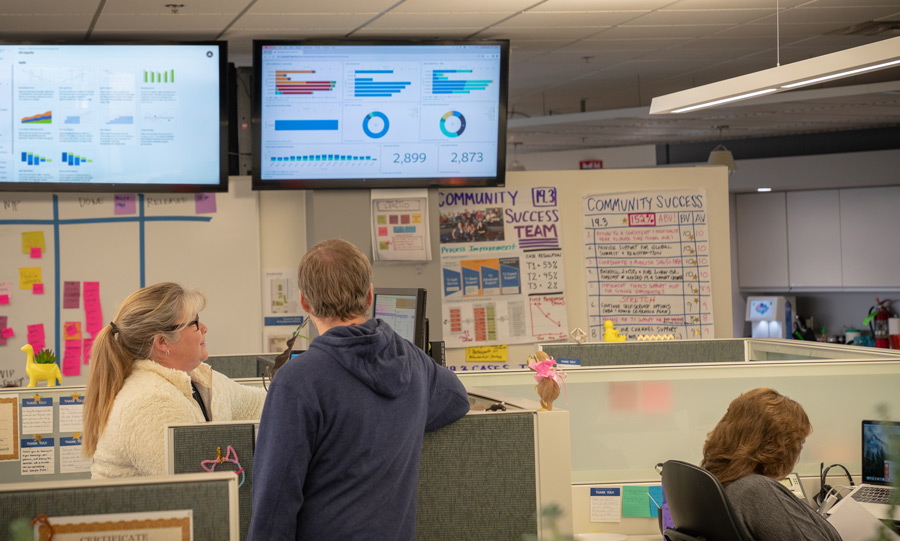
This real-time information needs appropriate tooling which collects data provided by the solutions themselves. (For more information, see the DevOps article.) It’s a worthwhile investment, however, as it visualizes the association between cause and effect and helps teams quickly assess the impact of frequent application changes, leading to faster issue resolution. The ‘public’ display of this information creates a healthy balance of accountability alongside a constant drive for relentless improvement.
Summary
In this article, we have shared some of the ways that successful enterprises have adapted their physical environments. All these changes have one thing in common: to remove the barriers to adopting Lean-Agile ways of working. Although making these changes can involve an initial investment, the business benefits delivered are substantial and make it worthwhile.
- Agile workspaces create the conditions for high-performing teams to emerge
- Space for cross-team collaboration and innovation ensures that we deliver on our short- and longer-term business objectives
- Visualizing the work brings opportunities for process improvement into focus and accelerates value delivery
Learn More
[1] Hesselberg, Jorgen. Unlocking Agility: An Insider’s Guide to Agile Enterprise Transformation. Addison-Wesley Signature Series (Cohn), Pearson Education.
Last update: 10 February 2021





